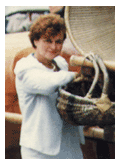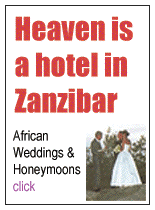|
...
|
|
|
|


 We're
#1 for Africa Fashions on Google and
Webtrends We're
#1 for Africa Fashions on Google and
Webtrends
Nigeria's
Chief of Fashion:
We met Chief Margaret Fabiyi at a conference in Cotonou,
Benin, West Africa in 1997. One year later, in Arusha,
Tanzania, we were treated to the first of a series of
fashion shows this talented lady has organized for Africa
Travel Association conferences. While enjoying luncheon at
Arusha's Impala Hotel, it was suddenly announced that a
fashion show was about to take place. To everyone's
surprise, the models turned out to be our own delegates -
and the variety of fashions for men and women, large and
petit, young and not so young - was superb. Chief Margaret
has staged encore presentations at ATA venues in Ethiopia
and Cape Town, South Africa She resides in Lagos, and her
company, Webisco, combines fashions and textiles with
cultural tours, including her annual Black History Month
series.
More
African
Fashions and Designers Win World Acclaim
By
Muguette Goufrani
 Africans
are painting the world in a kaleidoscope of bold, vibrant
color combinations and dazzling patterns. The rich fabrics
and virtually unlimited selection of turbans and other
festive headgear, bright scarves, colorful wraps, wearable
art and elegant gowns that brightened our days and lit up
our evenings in Morocco, Kenya, Ethiopia, Nigeria, Cameroon,
Cote d'Ivoire Uganda, Benin, Ghana, Zambia, South Africa,
Tanzania, Guinea and other African destinations, were simply
outstanding. What's more, so were the creators. During the
past decade as publishers, we've had the privilege of
meeting several of the brightest stars in Africa's fashion
galaxy, and thanks to the magic of serendipity, more will
surely appear in the near future. As I've learned, in many
African societies, the choice of colors and textiles has
special significance to the wearer. For example, hats often
tell stories of everyday life, with its struggles, spiced by
uplifting periods of joie de vivre. Africans
are painting the world in a kaleidoscope of bold, vibrant
color combinations and dazzling patterns. The rich fabrics
and virtually unlimited selection of turbans and other
festive headgear, bright scarves, colorful wraps, wearable
art and elegant gowns that brightened our days and lit up
our evenings in Morocco, Kenya, Ethiopia, Nigeria, Cameroon,
Cote d'Ivoire Uganda, Benin, Ghana, Zambia, South Africa,
Tanzania, Guinea and other African destinations, were simply
outstanding. What's more, so were the creators. During the
past decade as publishers, we've had the privilege of
meeting several of the brightest stars in Africa's fashion
galaxy, and thanks to the magic of serendipity, more will
surely appear in the near future. As I've learned, in many
African societies, the choice of colors and textiles has
special significance to the wearer. For example, hats often
tell stories of everyday life, with its struggles, spiced by
uplifting periods of joie de vivre.
 While
I have lived and worked in various North and West African
countries as an airline and travel agent, my media
involvement has brought the importance of African fashion
into sharp focus. How did this love affair start? Perhaps it
was at the first Africa Travel Association Fashion Show,
organized by Chief Margaret Fabiyi of Lagos, Nigeria. The
'Chief' has supplied many of my favorite wardrobe items ever
since. Here are some brief comments about her and others in
this fascinating field. While
I have lived and worked in various North and West African
countries as an airline and travel agent, my media
involvement has brought the importance of African fashion
into sharp focus. How did this love affair start? Perhaps it
was at the first Africa Travel Association Fashion Show,
organized by Chief Margaret Fabiyi of Lagos, Nigeria. The
'Chief' has supplied many of my favorite wardrobe items ever
since. Here are some brief comments about her and others in
this fascinating field.
Did you know our
website is #1 on Google for
Africa Travel Fashion?
Fashions
from the Spice Island: Zanzibar is an exotic East African
paradise of balmy beaches, fragrant spices, Swahili
lifestyle and rich cultural treasures. It was here during
the ATA's Seventh Cultural and Ecotourism Symposium, hosted
by Zanzibar Tourism, that Editor Jerry Bird and I had the
good fortune to meet and get to know Farouque Abdela. Each
of the many fashion items on display at the Zanzibar Beach
Resort Hotel that day was an individual work of art,
featured side by side with his partner's latest creations on
canvas. An international fashion designer, Abdela has worked
with Iman, Donna Karan, Christian Lacroix and other names in
the world of fashion.
.png) Alphadi
brings African Fashion to Europe: While returning to Paris
after an exciting month of business, conferences and touring
in Cameroon, we spent some quality time with Seidnaly
Alphadi, whose African- inspired creations have taken Europe
by storm. It seemed like half of the Cameroon Airlines plane
was filled with models from a Fashion Show our friend had
just staged in that Central African country. We continued
our fascinating interview at the Charles de Gaulle Airport
in Paris. Born in Niger, Alphadi's credentials include:
Founder - Festival International de la Mode Africaine and
President - Federation of African Creators. His global
recognition includes the Chevalier de l'Ordre de
Mérite de la France, Kora Fashion Award - South
Africa, and Meilleur Styliste Africain -
Fédération Française de la Couture et
du Prêt à Porter. Alphadi
brings African Fashion to Europe: While returning to Paris
after an exciting month of business, conferences and touring
in Cameroon, we spent some quality time with Seidnaly
Alphadi, whose African- inspired creations have taken Europe
by storm. It seemed like half of the Cameroon Airlines plane
was filled with models from a Fashion Show our friend had
just staged in that Central African country. We continued
our fascinating interview at the Charles de Gaulle Airport
in Paris. Born in Niger, Alphadi's credentials include:
Founder - Festival International de la Mode Africaine and
President - Federation of African Creators. His global
recognition includes the Chevalier de l'Ordre de
Mérite de la France, Kora Fashion Award - South
Africa, and Meilleur Styliste Africain -
Fédération Française de la Couture et
du Prêt à Porter.
 Vanessa
Ngango of Uganda, (right) a close friend is wearing a
Kinyadwanda attire.. Vanessa has launched an important cause
for environmental cleanup and mobiized the ladies of her
native country. It is Genesis Initiative. Also worth
visiting is Afromix,
the Portal of African and Caribbean Cultures. News, music,
arts and culture, society, travel,
events.http://www.afromix.org/ Vanessa
Ngango of Uganda, (right) a close friend is wearing a
Kinyadwanda attire.. Vanessa has launched an important cause
for environmental cleanup and mobiized the ladies of her
native country. It is Genesis Initiative. Also worth
visiting is Afromix,
the Portal of African and Caribbean Cultures. News, music,
arts and culture, society, travel,
events.http://www.afromix.org/
Cameroon's
Esterella Stars in Limbe: At a garden party, hosted by
Cameroon's Ministry of Tourism near the popular Limbe
Botanical Gardens, our group was treated to an outstanding
fashion show by 'Esterella,' one of Cameroon's top
designers. We made sure to renew our friendship with this
talented lady on a return visit several year's later, and
added to our archives of African fashion photography.
Esterella is the first of several Cameroonian fashion
designers on my recommended list.
Ethiopia's Rising
Star:
Guenet Fresenbet, known as Gigi, launched the first fashion
magazine in Ethiopia, with the message of promoting clothing
that is made in Ethiopia by Ethiopians. Gigi's desire is to
promote the Ethiopian textile and leather industry, so that
Ethiopia as well as other African nations can play a more
competitive role in the worldwide fashion industry. Gigi has
always had a passion for art - but decided to pursue a
career in the fashion industry in the late 80s after
studying fine arts and graphic design in the United States.
Although Gigi spent several years in the USA, she has always
had a desire to return to her homeland to promote Ethiopian
clothing and textiles. Her dreams have always been to see
Ethiopian clothing sold in finer stores throughout the
world.
Fashion through the
ages:
Coiffure and fashion wear is an expression of individuality
and pride for African women. For many centuries Africans
struggled to retain their unique traditions, languages and
cultures. This was achieved despite wave after wave of
outside influence and domination by Arabs and Europeans. One
of the features that has remained virtually intact from
generation to generation, was the African head wear. This
crowning glory symbolizes strength as well as pride in one's
self and one's city, village or country of birth. Attractive
hats and tie-wraps are a portrayal of femininity and
etiquette. Likewise, personal grooming and traditional hair
styles of West African women mirrors their social status.
African hats and head wraps are identified by their colorful
fabrics and distinctive designs. We enjoy every opportunity
to explore the cultural significance of African
fashion.
African
fashion has been a routine with our editorial team for
years, at home in Canada and away in Africa. It's a reminder
of the wide smiles, upbeat attitudes and lasting friendships
we enjoy. Like the pace and lifestyle of Africa ... it feels
natural.
Iman
Cosmetics:
Iman, daughter of a Somalian diplomat, might be called
the Estee Lauder for women of color. Iman distributes her
cosmetics in 700 shops in the USA. Now living in London and
married to David Bowie, she's rated among the 5 most
beautiful women in the world. Iman opened a shop in London
and South Africa in 1998. Her products are for women of many
races; Asian, Black, Hispanics and Arabs. Iman says that
Metis are in fashion and provides products for them. Colored
women were always ready to invest in cosmetics, a sector of
rapid expansion. What's termed minorities, represents the
majority of world population. In the USA, fifty percent of
the public will soon be colored, which represents a gigantic
purchasing power. We have to tell to the black women that
they are beautiful. I am against products which clear the
skin. Colored women sometimes use chemical products and
damage their skin. Those products should be controlled by
professional dermatologists.
.   
Oumou
Sy, Senegal's Queen of
Couture:
Where else does Western chic meet Afro-avant-garde but
in the creations of Oumou Sy, Senegal's Queen of Couture.
Her signature: bold fashion ideas which contain glamorous
Afro-centricism fused with universal style. Ms. Sy is not
only a prolific fashion designer, but she is also a stylist,
teacher, businesswoman and founder of the annual Dakar
Carnival and International Fashion Week in Dakar. Always on
the cutting edge, it was she (with her partners) who
pioneered cyber-cafe culture across all of Senegal.
(continued)
Mali Shows Off Fashions and Musical Talent: The Ministry of
Tourism and Handicrafts for the Republic of Mali showcased
the rich culture of Mali and its people at the Smithsonian
Folklife
Festival
on the National Mall in Washington, DC. In addition to the
great entertainment, Mali's musical ambassadors gave their
United States audience a sample of the country's colorful
fashions. Stay tuned for much more about Mali's role in the
world of fashion and design.
More->
Ethiopian
Artifacts and Antiques
.
The Fabric of West African
Lifestyle
Kente Cloth is an
Asante ceremonial cloth that is hand-woven on horizontal
treadle looms. The looms we observed in a village on the
outskirts of historic Kumasi were out in the open air,
although the weavers, in their wisdom, chose a grassy,
shaded area. Cloth strips, approximately 4 inches wide are
sewn together into larger bolts. Of many colors, sizes and
designs, Kente cloth products, long scarfs in particular,
are worn throughout Ghana and its neighboring countries,
during most social and religious occasions. The name is
derived from the word 'kenten,' which means basket. We saw
virtually every possible color and pattern of kente cloth
during the day-long Durbar ceremony at Koforidua village
near Accra. According to Ghanaians, kente depicts the area's
history and philosophy, its ethics, oral literature, moral
values, social and religious concepts. Several of the Kente
Cloth caps we purchased in Ghana in 1999 have been our
trademark at events ever since, and the colors are still
vibrant.
Instant Decision.
Fashion will Rule!
At Mrs. Fabiyi's
fashion affair in Arusha, Tanzania, we decided on the spot
that fashion would play a leading role in our magazine. The
exciting thing about this particular show, was the fact that
our own delegates from the USA and Africa participated as
models. That simple but effective format set the pattern for
future ATA fashion shows at congresses and symposia in
Ethiopia, South Africa, Cameroon, Guinea, Morocco, Zambia
and Zanzibar

|

![]()








 Africans
are painting the world in a kaleidoscope of bold, vibrant
color combinations and dazzling patterns. The rich fabrics
and virtually unlimited selection of turbans and other
festive headgear, bright scarves, colorful wraps, wearable
art and elegant gowns that brightened our days and lit up
our evenings in Morocco, Kenya, Ethiopia, Nigeria, Cameroon,
Cote d'Ivoire Uganda, Benin, Ghana, Zambia, South Africa,
Tanzania, Guinea and other African destinations, were simply
outstanding. What's more, so were the creators. During the
past decade as publishers, we've had the privilege of
meeting several of the brightest stars in Africa's fashion
galaxy, and thanks to the magic of serendipity, more will
surely appear in the near future. As I've learned, in many
African societies, the choice of colors and textiles has
special significance to the wearer. For example, hats often
tell stories of everyday life, with its struggles, spiced by
uplifting periods of joie de vivre.
Africans
are painting the world in a kaleidoscope of bold, vibrant
color combinations and dazzling patterns. The rich fabrics
and virtually unlimited selection of turbans and other
festive headgear, bright scarves, colorful wraps, wearable
art and elegant gowns that brightened our days and lit up
our evenings in Morocco, Kenya, Ethiopia, Nigeria, Cameroon,
Cote d'Ivoire Uganda, Benin, Ghana, Zambia, South Africa,
Tanzania, Guinea and other African destinations, were simply
outstanding. What's more, so were the creators. During the
past decade as publishers, we've had the privilege of
meeting several of the brightest stars in Africa's fashion
galaxy, and thanks to the magic of serendipity, more will
surely appear in the near future. As I've learned, in many
African societies, the choice of colors and textiles has
special significance to the wearer. For example, hats often
tell stories of everyday life, with its struggles, spiced by
uplifting periods of joie de vivre. While
I have lived and worked in various North and West African
countries as an airline and travel agent, my media
involvement has brought the importance of African fashion
into sharp focus. How did this love affair start? Perhaps it
was at the first Africa Travel Association Fashion Show,
organized by Chief Margaret Fabiyi of Lagos, Nigeria. The
'Chief' has supplied many of my favorite wardrobe items ever
since. Here are some brief comments about her and others in
this fascinating field.
While
I have lived and worked in various North and West African
countries as an airline and travel agent, my media
involvement has brought the importance of African fashion
into sharp focus. How did this love affair start? Perhaps it
was at the first Africa Travel Association Fashion Show,
organized by Chief Margaret Fabiyi of Lagos, Nigeria. The
'Chief' has supplied many of my favorite wardrobe items ever
since. Here are some brief comments about her and others in
this fascinating field..png) Alphadi
brings African Fashion to Europe: While returning to Paris
after an exciting month of business, conferences and touring
in Cameroon, we spent some quality time with Seidnaly
Alphadi, whose African- inspired creations have taken Europe
by storm. It seemed like half of the Cameroon Airlines plane
was filled with models from a Fashion Show our friend had
just staged in that Central African country. We continued
our fascinating interview at the Charles de Gaulle Airport
in Paris. Born in Niger, Alphadi's credentials include:
Founder - Festival International de la Mode Africaine and
President - Federation of African Creators. His global
recognition includes the Chevalier de l'Ordre de
Mérite de la France, Kora Fashion Award - South
Africa, and Meilleur Styliste Africain -
Fédération Française de la Couture et
du Prêt à Porter.
Alphadi
brings African Fashion to Europe: While returning to Paris
after an exciting month of business, conferences and touring
in Cameroon, we spent some quality time with Seidnaly
Alphadi, whose African- inspired creations have taken Europe
by storm. It seemed like half of the Cameroon Airlines plane
was filled with models from a Fashion Show our friend had
just staged in that Central African country. We continued
our fascinating interview at the Charles de Gaulle Airport
in Paris. Born in Niger, Alphadi's credentials include:
Founder - Festival International de la Mode Africaine and
President - Federation of African Creators. His global
recognition includes the Chevalier de l'Ordre de
Mérite de la France, Kora Fashion Award - South
Africa, and Meilleur Styliste Africain -
Fédération Française de la Couture et
du Prêt à Porter. Vanessa
Ngango of Uganda, (right) a close friend is wearing a
Kinyadwanda attire.. Vanessa has launched an important cause
for environmental cleanup and mobiized the ladies of her
native country. It is Genesis Initiative. Also worth
visiting is
Vanessa
Ngango of Uganda, (right) a close friend is wearing a
Kinyadwanda attire.. Vanessa has launched an important cause
for environmental cleanup and mobiized the ladies of her
native country. It is Genesis Initiative. Also worth
visiting is 



